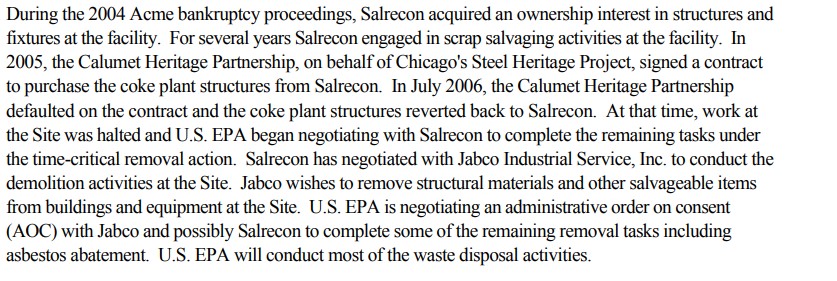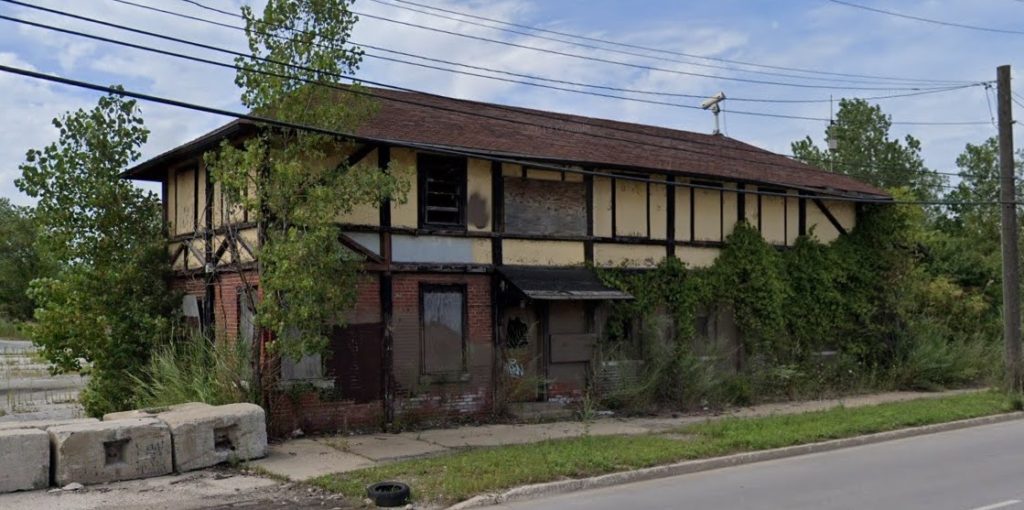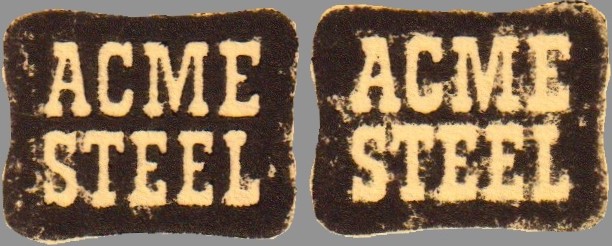A lot has gone on at 11236 S. Torrence between today and the time the plant closed, just shy of 20 years ago. Things went dark for a few years after everyone went home and the gates were locked up. The place hung in limbo for a time while some idealistic historians tried to hatch a plan to preserve the site, its structures and machines.
The earliest urban explorers probably had to climb a fence to get in. Some of them reported the power still being on and certainly the entire operation at ovens was intact. Door machine, pusher, larry car – all waiting to go. You could walk the bench around the batteries and get inside the coal bunker without having to walk up a slippery plank. I’m glad that this era was preserved and documented. You won’t find that evidence here – I was totally unaware of the plant. But I don’t have regrets or wish that I had gotten in on the ground floor. I know my place in the plant’s history and I am glad to fulfill it. But how did the plant get to the state it is in now? Stripped of anything salvageable, the plant hasn’t changed much in the last decade plus. What was the turning point?

According to this timeline, some amount of scrapping was conduced in the first three years after the shutdown in 2001. But largely, machinery was still intact as the Calumet Partnership was still trying to purchase it. In 2004, the blast furnace also closed and they began to work to purchase components of that (and have them stored at the coke plant). In July 2006 the plan fell apart and the paused stripping of the plant was about to spin back into action. The report doesn’t mention how long work was ‘halted’ but I think I may have found that answer.
I remember the first time I came back and truly explored the entire site. I marvel at the fact that while it was the middle of summer and a sunny, bright day, I saw no other explorers. I investigated every single structure that I knew of. But since I still had almost zero understanding of coke plant function, I had no idea of the ovens department that lie 1/4 south.
As such, I spent my afternoon in and around the main office and the other remaining structures: the storeroom, BP office, coal handling office and of course the gate house. The exterior on Torrence Ave to this day is quite ironic with it’s stained but vivid colors, almost from a pastel palette.

I remember going through the gate house, room by room. As one of the only structures with more than a ground floor, it is immersive. In the months since, I haven’t spent much time in the there. As winter set in, I would enter through the hole in the fence nearest the quench tower, then walk north through the property to the main office to begin my archeology for the day. Little by little I began to neglect the other structures I had spent time in before. It was just too cold to just ‘hang out’ – I had to work, and work quickly, then head back to Hegewisch.
This Saturday didn’t differ much from that description. But as I went to leave I felt uneasy. I felt like I was tearing myself away from the place as I got ready to mount up and head out. I felt conflicted and with the snow well past knee deep in places, the only way to kill time was to head back into the pastel cabin I had been missing for so long.
I roamed through the hallway in the back, and peeked under the stairs as I always have. I went up the stairs and stuck my head through the window to peer out at the rare vehicle speeding down Torrence on a Saturday morning. I just roamed in circles…up, down, front and back. I returned to the front door, and stood in the doorway looking south into the room where security must have once sat. The side door would have swung open and closed with drivers checking in and out, their trucks idling outside while shipping documents were squared away. An endless ream of dot matrix printer paper lies tangled on the ground behind the desk, intermingled with cardboard, debris, and dust. I have looked through this before, more than once. All junk, with any record of the busy traffic of drivers and employees long gone by the time I stepped foot in the slowly rotting structure just 8 months ago.
The door to the driveway is nailed shut. I walked over and slowly closed my eyes and thought about the chaos of a morning with a hundred or more of the lunch pail gang clocking in, and drivers lined up on both sides of the gate with deliveries or hauling goods out of the plant. To my right was a small card table with a smattering of filthy notes. I pushed them around and noticed a fast food menu, then another. Hot dogs, gyros, beef. One at 106th and another at 102th, surely both long gone, victims of the ravages of time, just like the coke plant.
Mixed in were blank bills of lading, custom templates that listed the furnace plant address on Burley at the location for ‘Acme Steel’. A great relic I was glad to tuck into my bag. And a sign in sheet for “ISM Security”. Seemed odd that Acme would hire a vendor to run the gate house, but I suppose anything is possible.

Then came the moment where instinct, taught hard by weeks and months of digging, spoke to me. It demanded that I have another look, and look carefully. And the more I searched, the more my instinct’s commands pushed me on. And I found that the room was filled with subtle but important artifacts of the time that the plant made the jump from abandoned to something else, and the ghosts moved in.

The EPA was right – Jabco had been here alright. And clearly they hired ISM to watch over the place. Surely scavengers had been in and out for the first 5 years but perhaps on a smaller scale. But once the real demolition started, the vultures could smell the ease at which they could carry things away – already partially disassembled, in a state of flux, maybe just waiting for the next dump truck the following morning. I’ve never stayed at the plant after dark but I’m sure it is harrowing. ISM was there 24 hours a day it looks like, and worse yet forced to ‘make the rounds’ in a rickety pickup truck, in the dawn of another cold Chicago November. The battery might just crank up enough to get started and hopefully get you back to your pastel sanctuary, lest you are left stranded in a darkness that blots out your breath and makes your ears scream with the lack of stimulation.

One of those November nights an early winter gale came through and knocked down some of the fence just near the locked driveway gate. Not a great deterrent against the circling birds of prey who knew more than well enough that Torrence and 112th in the earliest part of the AM hours is as desolate as any part of the city. I don’t know how many guards ISM staffed the tiny gate house with. But as relaxed as 16 visits have allowed me to be a place that once terrified me, I don’t know how good I’d feel about 4am with a truck that won’t start and the closest homes blocks away. It would be another few hours until the trucks came, and the sun with them.


And the trucks came, by the scores. They hauled ‘scrap’, according to most of the entries on the sign in sheets from May and June of 2007. Some hauled cast iron, others ‘stove brick’, measured by the number of presumably very heavy skids. They hauled asbestos, surely coating pipes all around the by-product plant. The decades had made the once safely coated poison now friable; crumbly as the topping on a coffee cake. Now it was bagged and ditched in Dalton.


On April 27th 2007, Jack Gray Trucking of Gary came away with 12 truck loads, many nearing 50,000 pounds of unknown payload. At least 10 trucks the week of May 11th swooped in, to take anything and everything.

So they stripped the plant, as well they should have and were sent in to do. While the wind blew the place to pieces, guards huddled in a chilly, dilapidated two story ‘house’ eating meatball sandwiches and pizza brought back from South Deering. And then the trail goes cold. Maybe by the end of 2007, the guards finally punched out for the last time at the pastel wonderland once the bricks, stone, iron, steel were all hauled off. The EPA delivered their most recent POLREP that year and none since. I can attest that not a scrap of anything metallic remains except the rebar buried in the floors of the main office, which look to make it to their 100th birthday in a few years, God willing.

I wonder how active the explorers were in those early days, or even 10 years ago. I know my era of this place, I know I’ve shared it with others. I’ve seen them, chatted with them and collaborated with some. Somehow 2001 seems too far away to make any sense of, I can’t bring myself to see the last man standing at Acme locking up and never coming back. I know it happened, but it is too distant for me to grasp. I know the space between – I see it every Saturday as I shiver and count the animal tracks in the fresh frost. But finding evidence of another interim civilization, active for their own span, busy and industrious, is riveting. It was short lived and when they disappeared, they set the place on its last orbit. The graffiti artists have thinned no doubt with so few blank canvasses left to imagine upon. Explorers come and go and some find enough there to appreciate. There will only be one 2007. 14 years later the plant waits, calmly and without impatience.

